,把type-a,type-d,type-e,type-f中的胖菱形分別做成紅色、粉紅色、黃色和綠藍色,以利於後期大圖的對齊和校正 ,make the fat rhombic in type-a, type-d, type-e and type-f as red, pink, yellow and green blue color respectively, in order for the benifit of the alignment and correction for the drawing of later on large penrose tiles drawing .with the middle line of the leftmost type-a as the reference for mirror symmetrical coupling, the result in Figure 4a is obtained. Similarly, for the second leftmost, the third leftmost, the fourth leftmost and the fifth leftmost midline as the reference, the graphics obtained by mirror image coupling are shown in Figure 4b, 4c, 4d, 4e, 4f. For the simplicity, here, just use the graph in fig 4 e as an example to continue the coupling in y-direction. the result of the specular deepest and specular shallowest are demonstrated in fig 6a and 7a, In the figure, many complex and chaotic completely indistinguishable patterns can be seen.. The correction results of the graphics in Fig and fig are shown in Figure b and fig b. After processing, a clear Penrose tiling diagram is obtained. It can be easily seen that the position of the defect belonging to the decagonal shape is easy to repair. Because, the non-matching position has a decagonal shape, it is easy to replace it with a proper decagon showing in fig 1b. , The other , as shown in the picture in Figure b, the defects are messy and take some time to process
In the two examples mentioned above, the revised tiles are no longer Penrose tiles under the traditional definition , because they don't have five-symmetry and mirror symmetry. They can be called Penrose-like tiles. After all, they are based on the original pattern of Penrose through a symmetrical coupling treatment, changed from. .After all, they are all based on Penrose's original model and transformed through symmetrical coupling processing.
Leaving aside the pictures above, let’s put them aside, and then look at the other coupling results. Figure 7 shows using the tiles in fig 5 making the shallowest coupling in the same phase direction , result as shown in Figure 5a, which show the boundary of these two tiles are fully compatible.
It needs to be emphasized here that the main synthesis scheme of the so-called penRose tiling in this paper is to use the coupling method to couple the six different decagons showing in Figure 1b together. In the synthesized Penrose diagram, if one more rhombus or brick does not belong to any of the above six regular decagons, it is considered as a defect or the lack of a rhombus in any decagon is also considered a defect..
以最左邊的type-a的中間線為基準作鏡面對稱偶合,得到圖4a的結果。同樣的對第二最左邊,第三最左邊, 第4最左邊 第5最左邊的中線為基準,做鏡像偶合得到的圖形如圖4b,4c, 4d, 4e, 4f的結果,
,以最左邊 type-a的中線為基准進行鏡像對稱耦合,得到圖4a的結果。同理,對於第二左、左三、左四、左五中線為基準,鏡像耦合得到的圖形如圖4b、4c、4d、4e、4f所示。
為了簡單起見,這裡僅以圖4e中的圖形為例,繼續y方向的耦合。specular deepest 和 specular shallowest 的結果如圖 6a 和 7a 所示,圖中可以看到許多複雜和混亂的完全無法區分的圖案。為了簡單起見,這裡僅以圖4e中的圖形為例,繼續y方向的耦合。鏡面最深和鏡面最淺的結果如圖 6a 和 7a 所示。圖中可以看到圖中許多的複雜錯亂的完全不可分辨的圖案
以圖4c的結果再繼續做Y方向的藕合處理,先做最淺和最深的y方向藕合處理。其結果如圖5a,5b,在以可以看到圖中許多的複雜錯亂的完全不可分辨的圖案。
Fig和fig中圖形的修正結果如圖b和fig b所示. 處理後得到清晰的彭羅斯鋪磚圖。
It can be easily seen that the position of the defect belonging to the decagonal shape is easy to repair. Because, the non-matching position has a decagonal ape, it is easy to replace it with a proper decagon as shown in fig 1b.. 處理後得到清晰的Penrose平鋪圖。很容易看出,屬於十邊形的缺陷位置易於修復。因為,非匹配位置具有十邊形形狀,所以很容易用圖 1b 中所示的適當十邊形替換它。
,..,如圖b的圖片所顯示的,缺陷很亂,需要一些時間來處理。如圖所顯示的位置像圖顯示,缺陷是很雜亂的,需要花上一些時間處理。
以上舉的兩個例子,修正後的磁磚已經不是傳統定義下的彭洛斯磁磚,具有五稱對稱以及鏡像對稱,可以稱之為類彭羅斯磁磚,
...在上面提到的兩個例子中,修改後的瓦片不再是傳統定義下的彭羅斯瓦片,因為它們不具有五對稱性和鏡像對稱性。畢竟都是在Penrose原來的模型基礎上,經過對稱耦合處理改造而成的。它們可以稱為 Penrose-like tiles。
畢竟他們是以彭羅斯原始圖案經過對稱偶合處理,改變而成的。這些修改的號稱彭羅斯圖磚上,是沒有所謂的缺陷問題,是沒有缺陷的,依照彭羅斯鋪磚的定義,是由胖瘦不同的兩個菱形拼成的,但必須是五重對稱性和鏡像對稱性。.
拋開上面的圖片不談,先放一邊,再看看其他的耦合結果。圖 7 顯示使用圖 5 中的瓦片在相同的相位方向上進行最淺的耦合,結果如圖 5a 所示,這表明這兩個瓦片的邊界完全兼容
.這裡需要強調的是,本文所謂的penRose tiling的主要合成方案是使用耦合的方法將圖1b中所示的六個不同的十邊形耦合在一起。在合成的彭羅斯圖中,如果多出一個菱形或磚塊不屬於上述六個正十邊形中的任何一個,則視為缺陷或任何十邊形中缺少菱形也算缺陷。
是一個 可以完全互配的藕合,修改缺陷的結果如圖5b,圖6,是Y方向鏡像藕合,結果如圖6a,缺陷校正的結果如 。這裡需要強調一下,在這篇論文所謂的penRose鋪磚主要的合成方案是用藕合的方法將圖圖1b六種不同的10邊形藕合在一起,在合成的penRose圖,如果多出一個菱形或方塊不屬於上述任何六個正十方型之一的,就算做是缺陷。或者任何十方型少掉一個菱形,也算做是缺陷。
可以看出屬於正十方型的缺陷位置是很容易修復的,如果非比配的位置是有正十方形的樣形,是很容易由適當的十方型取代,如圖所顯示的位置像圖顯示,缺陷是很雜亂的,需要花上一些時間處理。
以上舉的兩個例子,修正後的磁磚已經不是傳統定義下的彭洛斯磁磚,具有五稱對稱以及鏡像對稱,可以稱之為類彭羅斯磁磚,畢竟他們是以彭羅斯原始圖案經過對稱偶合處理,改變而成的。
這些修改的號稱彭羅斯圖磚上,是沒有缺陷的,依照彭羅斯鋪磚的定義,是由胖瘦不同的兩個菱形拼成的,但必須是五重對稱性和鏡像對稱性。是沒有所謂的缺陷問題。
先撇開上述的圖片不說,放在一邊。再看看 之外的藕合結果,圖7是圖5中的鋪磚做同相 方向 的最淺藕合,如圖5a,是一個 可以完全互配的藕合,修改缺陷的結果如圖5b,圖6,是Y方向鏡像藕合,結果如圖6a,缺陷校正的結果如 。這裡需要強調一下,在這篇論文所謂的penRose鋪磚主要的合成方案是用藕合的方法將圖圖1b六種不同的10邊形藕合在一起,在合成的penRose圖,如果多出一個菱形或方塊不屬於上述任何六個正十方型之一的,就算做是缺陷。或者任何十方型少掉一個菱形,也算做是缺陷。
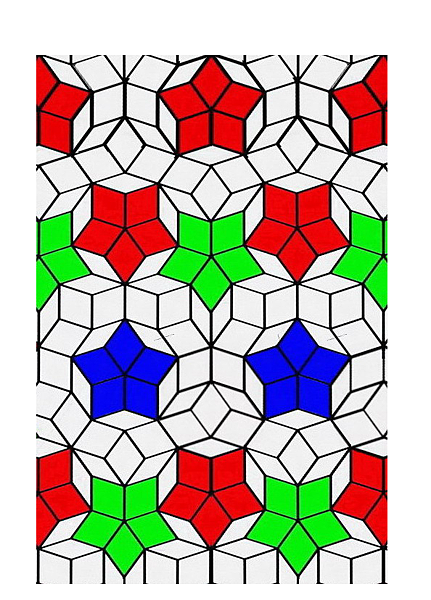 觀測到的最小基本晶胞 Lx 為 9.96a,Ly 為 13.114a,Lx/Ly 為 0.76 The smallest elementary unit cell being observed Lx is 9.96a, Ly is 13.114a, Lx/Ly is 0.76
觀測到的最小基本晶胞 Lx 為 9.96a,Ly 為 13.114a,Lx/Ly 為 0.76 The smallest elementary unit cell being observed Lx is 9.96a, Ly is 13.114a, Lx/Ly is 0.76
Rolling up unit cell on x-direction, makes a smallest Penrose-tiling nanotube with circumference length equal L x ,9.96a, with radius L1 =1.585a ( 9.96a/2pei), and rolling up on y-direction makes another second smallest one with circumference length 13.14, radius l2=2.087 ( 13.14a/2 pei), Considering of pattern symmetry on a tube, it is suggested to take two times Lx as the periph as a second smallest tube, then, Ly is the periphy for smallest tube. 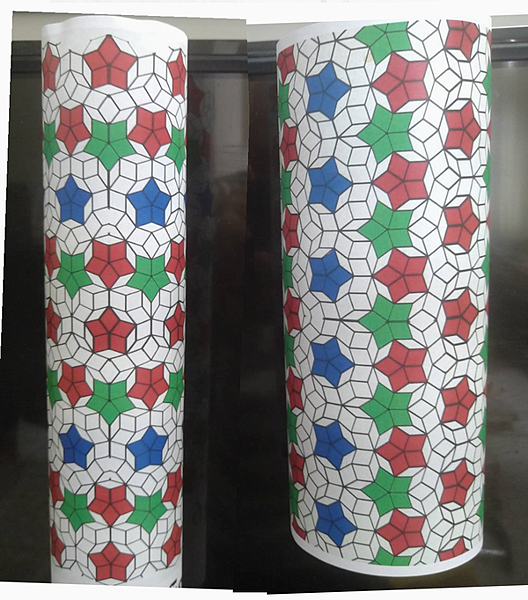
We may have three ways to construct a multiple concentric nanotubes, with the order of tube radius (A) l1,2l1,3l1,,(B) l2, 2l2, 3l2,,,,(C) l1,l2,2l1,2l2,,
.Very similar to rolling up of different types of carbon nanotube. Other types of Penrose tiles of different radii can be obtained by rolling a unit cell rotated by 18 degrees or 54 desrees.
Summary: An elementary unit cell can be extracted from repeated coupling results, and this unit cell can be recombined (tessellated, mosaiced) to build translational periodic Penrose tiles. And a model of Penrose multiple concentric nanotube is established to facility a further 3-D 平移週期的彭羅斯平鋪可以捲起來形成彭羅斯平鋪納米管,就像納米碳管的行為一樣。Penrose 多層同心納米管可以提供重要的可視化效果,說明如何在兩個近端層之間建立潛在的鍵合連接,並構建半 3-D 模型以促進進一步的 3-D Penrose .One may make several layers of translational Penrose tiling piling up with a distance "a" apart with each other, then each adjacent layer may be made a 36 degree or a 72 degreesslant shift(twist) , thus demonstrated a pseudo three dimensional Penrose tilings,
儘管(但是)translational 彭羅斯拼塊在幾何上的行為類似於原子碳層, 可以使幾層平移的彭羅斯平鋪堆疊在一起,彼此之間的距離為“a”,然後每個相鄰層進行 36 度或 72 度的斜移,從而展示偽三維彭羅斯平鋪,
兩層之間任意方向夾角36度或72度。
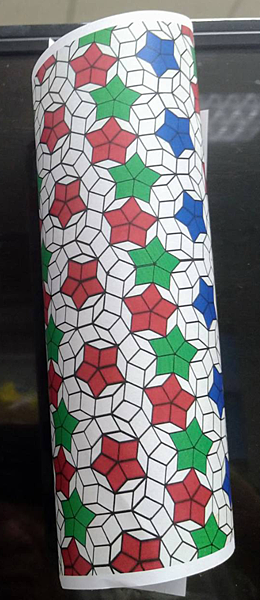
by rolling up a 18 degreesrotated the unit cell ,
Penrose-tiling studies.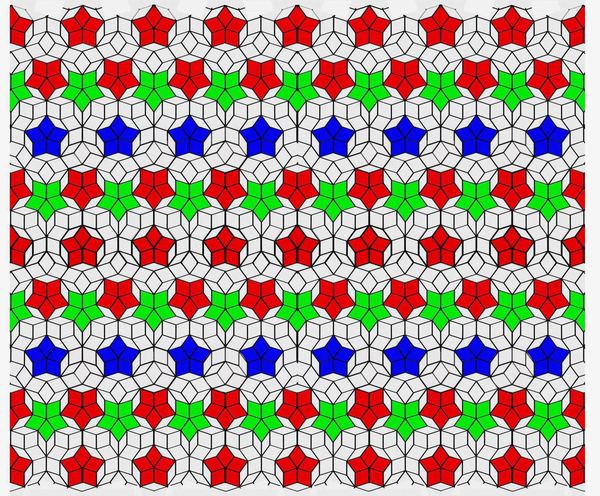
fig Translational Penrose tiing
The translational periodic Penrose tiling can be rolled up to form a Penrose tiling nanotube, just like the behavior of carbon nanotube. Penrose multilayer concentric nanotubes can provide important visualizations of how a potential bonding connection is established between two proximal layers and build a semi-3-D model to facilitate further 3-D Penrose. 平移週期的彭羅斯平鋪可以捲起來形成彭羅斯平鋪納米管,就像納米碳管的行為一樣。Penrose 多層同心納米管可以提供重要的可視化效果,說明如何在兩個近端層之間建立潛在的鍵合連接,並構建半 3-D 模型以促進進一步的 3-D Penrose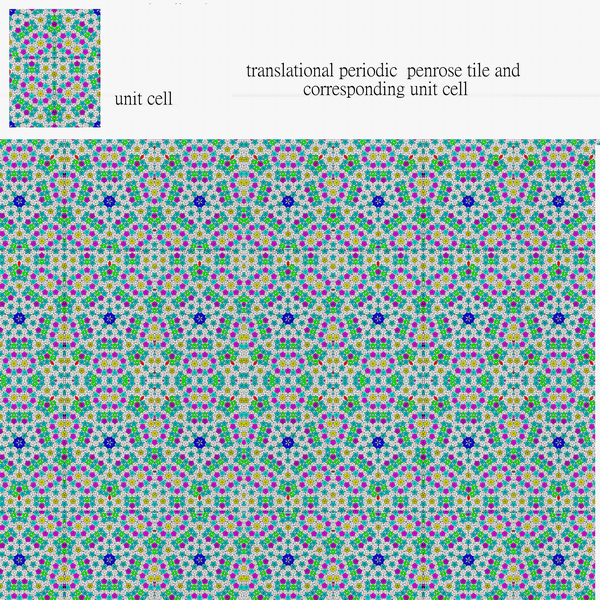


 留言列表
留言列表


